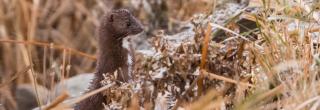 |
| Fact Sheet |
| Scientific Name |
Mustela vison |
| Description |
Mink have a typical weasel-like body with a slender form and a short, bushy tail. They are brown to nearly black and often have a white patch on their chin, throat or chest. Their fur is shorter than that of an American marten or fisher. |
Tracks |
Front/Rear– 1-1/4" L, 1-1/2" W Walking stride: 3-1/2" - 7-3/4" |
| Total Length |
11-27 inches |
| Weight |
1-4 pounds |
| Habitat |
Mink are found throughout North Dakota, but are more prevalent in the eastern half of the state. Mink are semi-aquatic and are associated with streams, rivers, wetlands, ponds and lakes. However, they are known to forage in uplands and are capable of climbing trees. |
| Breeding Season |
February-April. Fertilized eggs then may or may not delay implantation for up to 45 days. |
| Gestation Period |
30-32 days |
| Litter Size |
2-8 (average 4) |
| Social Aspects |
Mink are solitary, except when breeding or rearing young. |
| Status |
North Dakota's mink population is stable and there is a limited harvest season. |
| Food Habits |
Mink are strictly carnivorous and prey includes muskrats, fish, frogs, crayfish, birds (especially waterfowl), eggs and small rodents. |
| Fun Facts |
Mink were the most valuable furbearer in North Dakota during the 1950s and 1960s, and sales of their fur by North Dakota trappers averaged more than $220,000 per year during this time. Since then, increasing numbers of farm-raised mink have lessened the demand for wild animals. |


